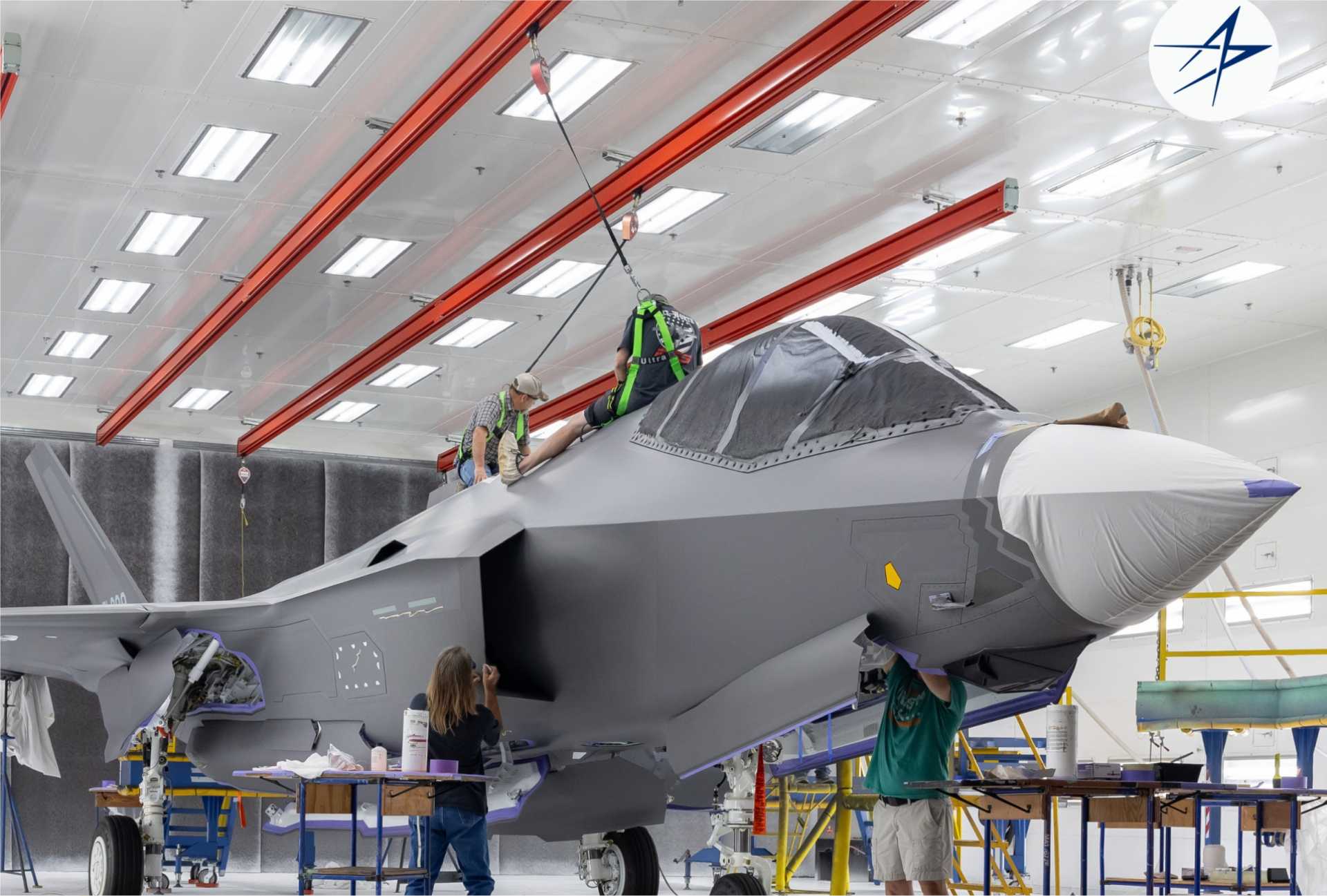Exclusive: First Belgian F-35 Fighter Jet Nears Maiden Flight After Final Finishing Stage

{loadposition bannertop}
{loadposition sidebarpub}
According to information published by the Lockheed Martin Europe X account on July 9, 2025, Belgium’s first F-35A Lightning II fighter jet is currently in the final finishing phase ahead of its inaugural flight. This crucial milestone includes the application of radar-absorbent stealth coatings, stealth signature validation, mission system calibration, and full integration of NATO-standard combat software. The aircraft is undergoing comprehensive ground-based testing to ensure all structural, electronic, and low observable features meet operational specifications before flight certification. Once complete, the aircraft will represent Belgium’s first domestically prepared F-35 and will mark the beginning of a new generation of Belgian air combat capability.Follow Army Recognition on Google News at this link
Final finishing touches are being applied to Belgium’s first F-35A fighter jet, including stealth coating and system checks, as it prepares for its maiden flight ahead of delivery to the Belgian Air Force. (Picture source: Lockheed Martin)
Belgium’s F-35 program originated with a decision made in October 2018, when the Belgian government selected the F-35A to replace its aging fleet of F-16A/B MLU fighters. The initial contract covered the procurement of 34 F-35A aircraft through the U.S. Foreign Military Sales (FMS) program. The decision followed an extensive evaluation process prioritizing interoperability with NATO, future-readiness, and advanced multi-domain operational capacity. The F-35A offered Belgium a fifth-generation solution tailored for contested airspace, with stealth capability, full-spectrum sensor fusion, and multirole performance across air-to-air, ground attack, and ISR missions.
The F-35A is the conventional takeoff and landing (CTOL) variant of the F-35 Lightning II family, developed by Lockheed Martin for the U.S. Air Force and allied air forces. Unlike the carrier-based F-35C or vertical takeoff F-35B, the F-35A is optimized for operations from standard NATO airbases and is the lightest, most agile variant. It incorporates a powerful AN/APG-81 AESA radar, Electro-Optical Targeting System (EOTS), and Distributed Aperture System (DAS), which provide the pilot with unmatched situational awareness and targeting precision. It is the only variant certified to carry the U.S. B61 tactical nuclear bomb, making it central to NATO’s nuclear sharing posture—a mission in which Belgium plays a critical role.
On July 2, 2025, Belgium’s Ministry of Defence officially confirmed through its updated Defence Strategic Plan that it would acquire an additional 11 F-35A aircraft, raising the total planned fleet to 45. This expansion is directly linked to NATO’s call for enhanced force availability to support collective deterrence operations in Europe, particularly the nuclear umbrella aimed at deterring further Russian aggression. Belgian defense planners acknowledged that the original order of 34 aircraft was insufficient to cover full operational demands, including quick reaction alerts, training, and continuous readiness cycles. The new order ensures Belgium can meet NATO’s force generation requirements while also preparing for long-term defense autonomy.
The first four Belgian F-35As have already been delivered and are currently stationed at Luke Air Force Base in the United States, where they are being used for pilot conversion and advanced aircrew training. This training program, conducted in cooperation with the U.S. Air Force, will enable Belgian pilots and ground personnel to develop full proficiency in operating and sustaining the fifth-generation platform before its deployment in Europe.
The first Belgian-operated F-35As are scheduled to arrive at Florennes Air Base in October 2025. The base has undergone significant infrastructure upgrades to accommodate the platform, including climate-controlled stealth shelters, encrypted datalink integration, and advanced mission support facilities. Florennes will serve as the primary operational base, with Kleine Brogel Air Base designated as the second hub, where aircraft will likely assume NATO dual-capable alert roles. This basing plan aligns with Belgium’s long-standing participation in NATO’s nuclear deterrence structure.
With full fleet delivery expected by the end of the decade, Belgium aims to achieve initial operational capability (IOC) with the F-35A by 2027, followed by full operational capability (FOC) by 2030. During this transition, the Belgian Air Component will begin the phased retirement of its F-16 fleet, which has served as the backbone of Belgian air defense since the late 1970s. The induction of the F-35 will not only modernize Belgium’s air capabilities but also transform its strategic profile within NATO, providing a stealth-enabled, multi-domain-ready force compatible with the alliance’s future operating concepts.
Belgium’s expanded F-35 program also carries industrial and geopolitical weight. By investing in the world’s most advanced multirole combat aircraft, Belgium reinforces its defense partnership with the United States while simultaneously enhancing Europe’s integrated deterrence capacity. The participation of Belgian industry in the F-35 global supply chain is also expected to grow, supporting defense-related technology transfers and long-term maintenance opportunities.
With 45 U.S. F-35A fighter jets now on order and its first domestically assembled jet nearing flight, Belgium is taking decisive steps toward establishing itself as a fully capable fifth-generation air force. This program will shape the future of Belgian airpower and its role in European security for decades to come. Army Recognition will continue to provide exclusive coverage of all developments related to the Belgian F-35 program, including aircraft deliveries, operational milestones, and NATO integration updates.

{loadposition bannertop}
{loadposition sidebarpub}
According to information published by the Lockheed Martin Europe X account on July 9, 2025, Belgium’s first F-35A Lightning II fighter jet is currently in the final finishing phase ahead of its inaugural flight. This crucial milestone includes the application of radar-absorbent stealth coatings, stealth signature validation, mission system calibration, and full integration of NATO-standard combat software. The aircraft is undergoing comprehensive ground-based testing to ensure all structural, electronic, and low observable features meet operational specifications before flight certification. Once complete, the aircraft will represent Belgium’s first domestically prepared F-35 and will mark the beginning of a new generation of Belgian air combat capability.
Follow Army Recognition on Google News at this link
Final finishing touches are being applied to Belgium’s first F-35A fighter jet, including stealth coating and system checks, as it prepares for its maiden flight ahead of delivery to the Belgian Air Force. (Picture source: Lockheed Martin)
Belgium’s F-35 program originated with a decision made in October 2018, when the Belgian government selected the F-35A to replace its aging fleet of F-16A/B MLU fighters. The initial contract covered the procurement of 34 F-35A aircraft through the U.S. Foreign Military Sales (FMS) program. The decision followed an extensive evaluation process prioritizing interoperability with NATO, future-readiness, and advanced multi-domain operational capacity. The F-35A offered Belgium a fifth-generation solution tailored for contested airspace, with stealth capability, full-spectrum sensor fusion, and multirole performance across air-to-air, ground attack, and ISR missions.
The F-35A is the conventional takeoff and landing (CTOL) variant of the F-35 Lightning II family, developed by Lockheed Martin for the U.S. Air Force and allied air forces. Unlike the carrier-based F-35C or vertical takeoff F-35B, the F-35A is optimized for operations from standard NATO airbases and is the lightest, most agile variant. It incorporates a powerful AN/APG-81 AESA radar, Electro-Optical Targeting System (EOTS), and Distributed Aperture System (DAS), which provide the pilot with unmatched situational awareness and targeting precision. It is the only variant certified to carry the U.S. B61 tactical nuclear bomb, making it central to NATO’s nuclear sharing posture—a mission in which Belgium plays a critical role.
On July 2, 2025, Belgium’s Ministry of Defence officially confirmed through its updated Defence Strategic Plan that it would acquire an additional 11 F-35A aircraft, raising the total planned fleet to 45. This expansion is directly linked to NATO’s call for enhanced force availability to support collective deterrence operations in Europe, particularly the nuclear umbrella aimed at deterring further Russian aggression. Belgian defense planners acknowledged that the original order of 34 aircraft was insufficient to cover full operational demands, including quick reaction alerts, training, and continuous readiness cycles. The new order ensures Belgium can meet NATO’s force generation requirements while also preparing for long-term defense autonomy.
The first four Belgian F-35As have already been delivered and are currently stationed at Luke Air Force Base in the United States, where they are being used for pilot conversion and advanced aircrew training. This training program, conducted in cooperation with the U.S. Air Force, will enable Belgian pilots and ground personnel to develop full proficiency in operating and sustaining the fifth-generation platform before its deployment in Europe.
The first Belgian-operated F-35As are scheduled to arrive at Florennes Air Base in October 2025. The base has undergone significant infrastructure upgrades to accommodate the platform, including climate-controlled stealth shelters, encrypted datalink integration, and advanced mission support facilities. Florennes will serve as the primary operational base, with Kleine Brogel Air Base designated as the second hub, where aircraft will likely assume NATO dual-capable alert roles. This basing plan aligns with Belgium’s long-standing participation in NATO’s nuclear deterrence structure.
With full fleet delivery expected by the end of the decade, Belgium aims to achieve initial operational capability (IOC) with the F-35A by 2027, followed by full operational capability (FOC) by 2030. During this transition, the Belgian Air Component will begin the phased retirement of its F-16 fleet, which has served as the backbone of Belgian air defense since the late 1970s. The induction of the F-35 will not only modernize Belgium’s air capabilities but also transform its strategic profile within NATO, providing a stealth-enabled, multi-domain-ready force compatible with the alliance’s future operating concepts.
Belgium’s expanded F-35 program also carries industrial and geopolitical weight. By investing in the world’s most advanced multirole combat aircraft, Belgium reinforces its defense partnership with the United States while simultaneously enhancing Europe’s integrated deterrence capacity. The participation of Belgian industry in the F-35 global supply chain is also expected to grow, supporting defense-related technology transfers and long-term maintenance opportunities.
With 45 U.S. F-35A fighter jets now on order and its first domestically assembled jet nearing flight, Belgium is taking decisive steps toward establishing itself as a fully capable fifth-generation air force. This program will shape the future of Belgian airpower and its role in European security for decades to come. Army Recognition will continue to provide exclusive coverage of all developments related to the Belgian F-35 program, including aircraft deliveries, operational milestones, and NATO integration updates.





